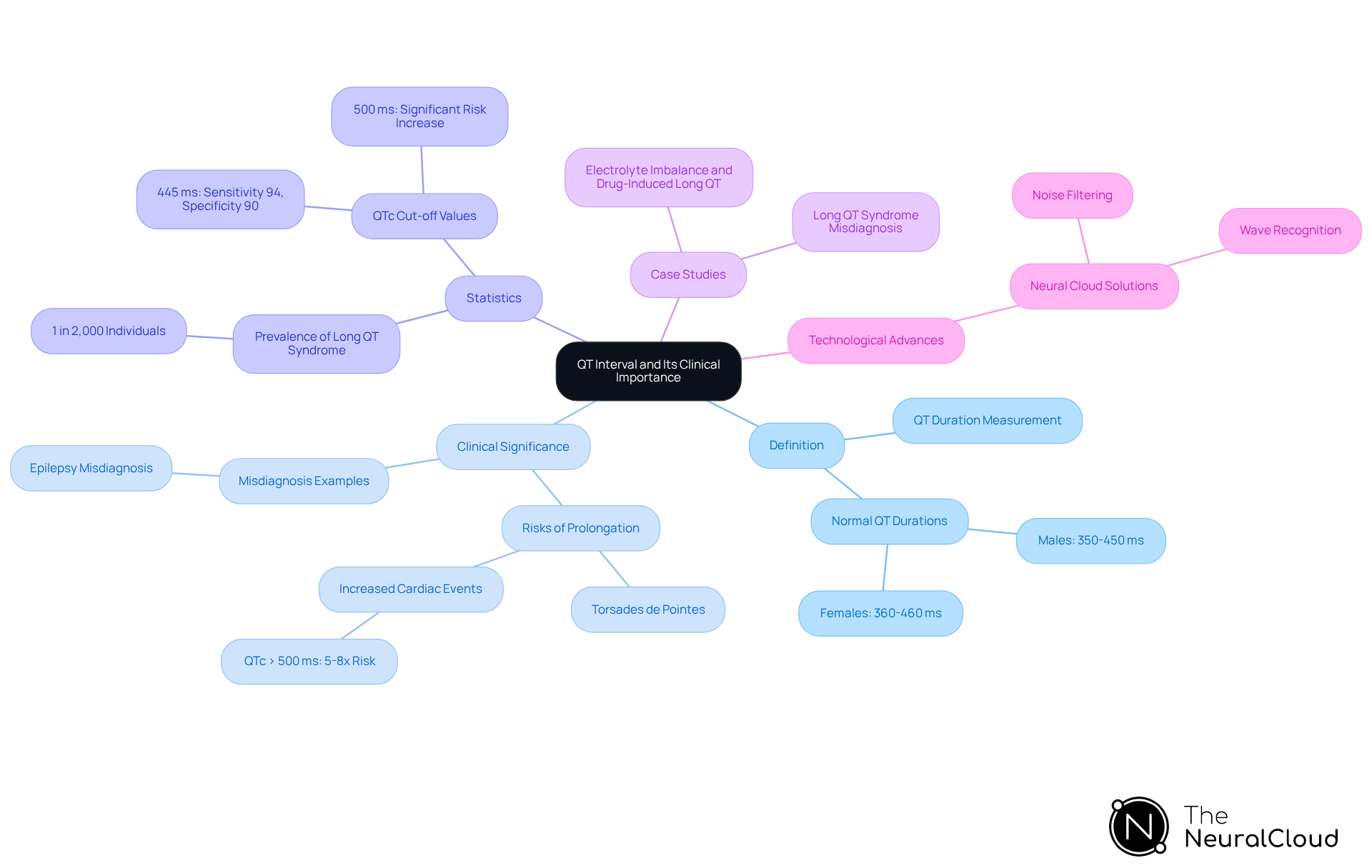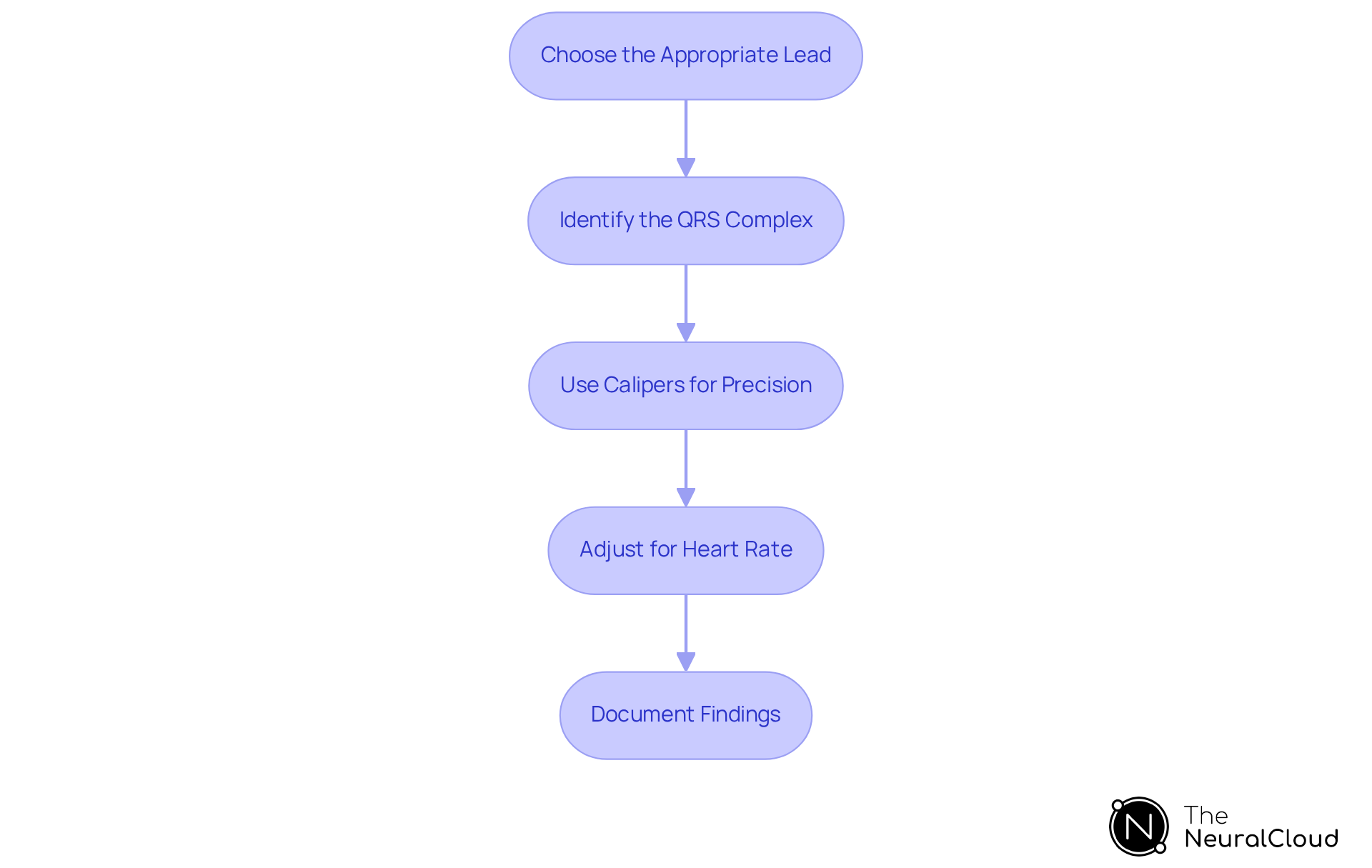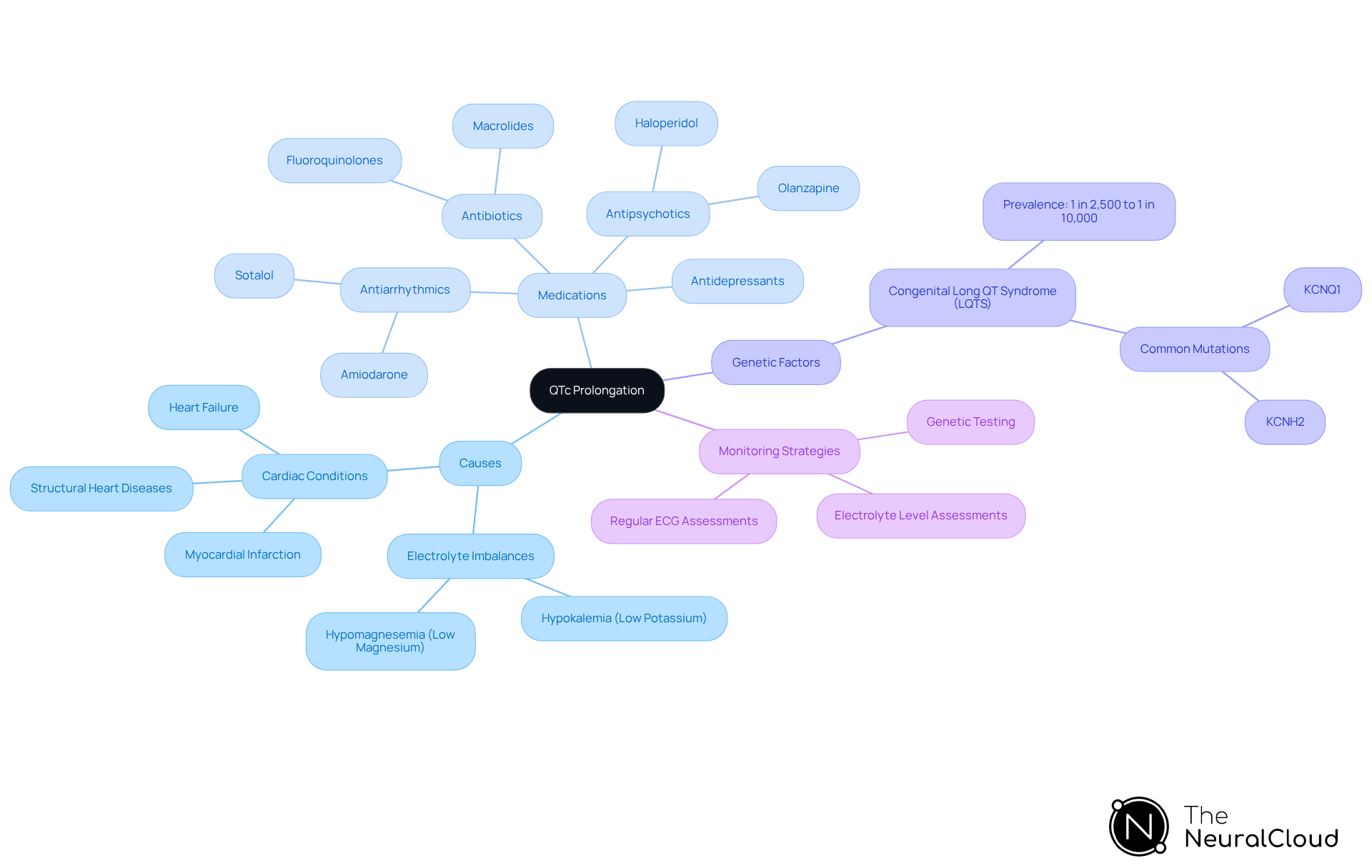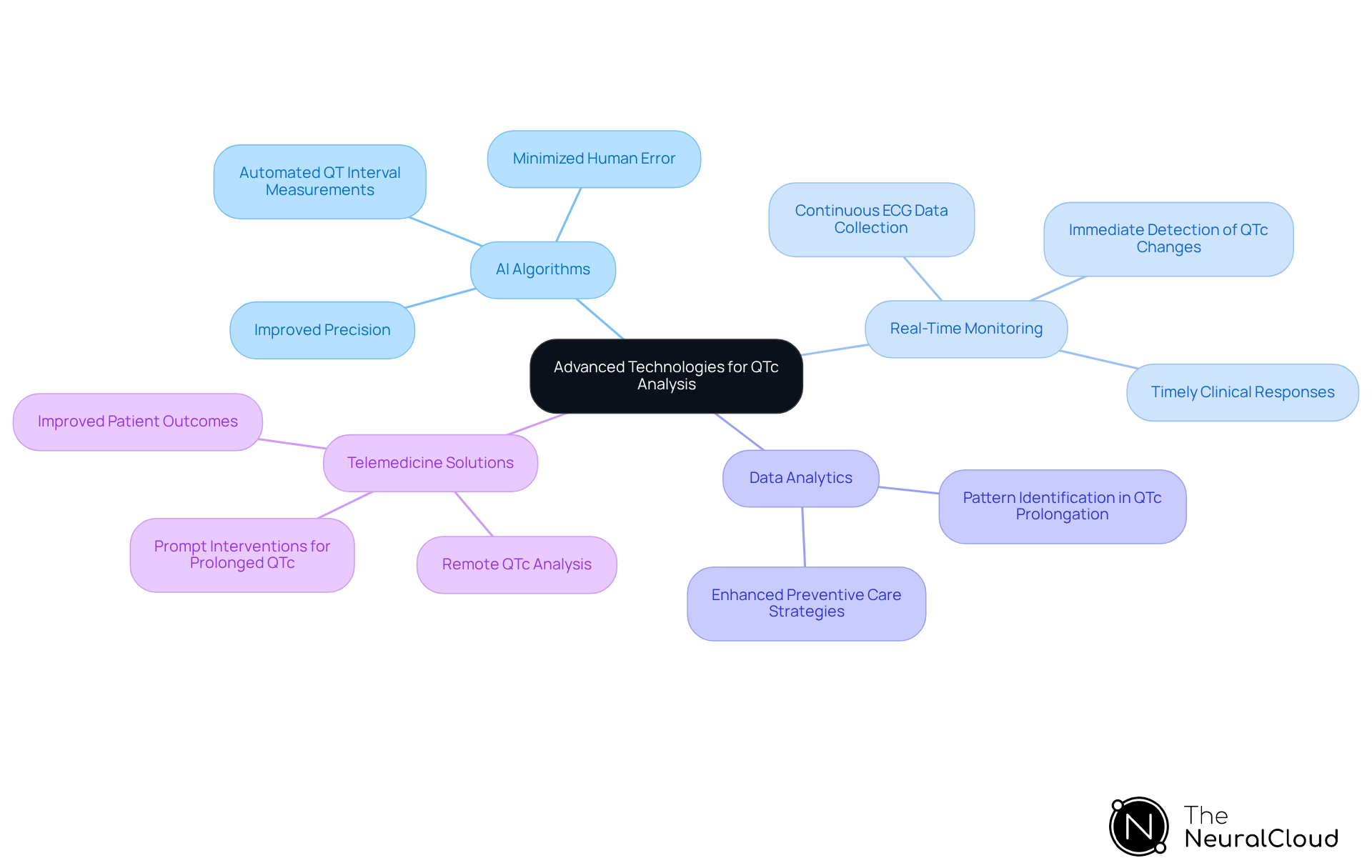Overview
The article discusses advanced techniques for mastering electrocardiogram QTc analysis, highlighting the clinical importance of accurately measuring the QT interval to avert life-threatening arrhythmias. It outlines the risks associated with QT prolongation and underscores the necessity of precise measurement methods. Furthermore, it details how advanced technologies, such as Neural Cloud Solutions' MaxYield™ platform, enhance the accuracy and efficiency of QTc evaluations. This ultimately leads to improved patient safety and outcomes.
In the realm of ECG analysis, healthcare professionals face significant challenges, including the complexity of QT interval measurement and the potential for misinterpretation. The MaxYield™ platform addresses these challenges by offering features designed to streamline the analysis process. With its advanced algorithms, the platform ensures precise QT interval measurements, which are crucial for identifying patients at risk of arrhythmias.
The advantages of the MaxYield™ platform extend beyond mere accuracy. By integrating cutting-edge technology into ECG analysis, healthcare professionals can enhance their workflow efficiency. The platform not only reduces the time required for evaluations but also minimizes the risk of human error, thereby fostering a safer clinical environment.
In summary, the MaxYield™ platform represents a significant advancement in QTc analysis. Its features provide healthcare professionals with the tools necessary to conduct thorough evaluations, ultimately leading to better patient care. By leveraging such technology, practitioners can ensure that they are equipped to make informed decisions, significantly impacting patient outcomes.
Introduction
The QT interval is a vital marker in the analysis of electrocardiograms, reflecting the heart's electrical activity and its potential vulnerabilities. As medical professionals increasingly recognize the importance of accurate QTc assessment, mastering advanced techniques becomes essential for enhancing patient safety and outcomes. However, various factors influence QT prolongation, and the complexities of ECG interpretation raise the question: how can clinicians effectively identify and manage at-risk patients? This article explores the nuances of QTc analysis, delving into innovative methods and technologies that empower healthcare providers to navigate these challenges with confidence.
Define the QT Interval and Its Clinical Importance
The QT duration, measured on an electrocardiogram QTc from the beginning of the Q wave to the end of the T wave, indicates the length of ventricular depolarization and repolarization. Its clinical importance is paramount, as prolongation of the QT duration can lead to serious arrhythmias, notably Torsades de Pointes, which poses a life-threatening risk.
Approximately 1 in 2,000 individuals in the United States are affected by long QT syndrome, a condition that can precipitate these dangerous arrhythmias. Normal QT durations are influenced by heart rate, necessitating the use of the electrocardiogram QTc value for precise evaluation. A QTc value exceeding 500 milliseconds, as shown on an electrocardiogram QTc, significantly increases the risk of cardiac events, with studies indicating a five- to eightfold increase in risk for individuals under 40 years of age.
Understanding the from the electrocardiogram QTc allows healthcare providers to identify individuals at risk for cardiac events and customize management strategies effectively. Recent case studies have underscored the necessity for accurate measurement methods, as errors in QT duration assessment can lead to misdiagnosis and inappropriate treatment.
For example, an individual initially misdiagnosed with epilepsy was later found to have long QT syndrome, highlighting the critical need for vigilance in ECG interpretation. By recognizing the implications of QT duration abnormalities, clinicians can enhance safety and improve patient outcomes.
The incorporation of Neural Cloud Solutions' platform, which utilizes advanced noise filtering and unique wave recognition, enables clinicians to enhance the precision of QT duration evaluations. MaxYield™ rapidly isolates ECG waves from recordings affected by noise and artifacts, salvaging previously obscured sections from lengthy Holter, 1-Lead, and patch monitor recordings. This ensures that critical data is not overlooked, ultimately improving patient safety and outcomes.

Measure the QT Interval: Techniques and Best Practices
To measure the QT interval accurately, it is essential to follow best practices that enhance precision and reliability:
- Choose the Appropriate Lead: Utilize lead II or V5 for optimal visibility of the QT segment. These leads provide clearer representations of cardiac activity, facilitating accurate analysis.
- Identify the QRS Complex: Locate the beginning of the Q wave and the end of the T wave. The end of the T wave is typically defined by its return to the baseline, which can be challenging due to variations in T wave morphology. Neural Cloud Solutions' MaxYield™ platform enhances this process by effectively managing physiological variability, ensuring more accurate identification of the QRS complex.
- Use Calipers for Precision: Employ calipers or digital tools to measure distances accurately, taking into account any baseline wander. This is crucial, as research indicates that fewer than 25% of doctors can correctly categorize QT durations, underscoring the necessity for reliable measurement methods. MaxYield™ automates this process, improving measurement accuracy through advanced algorithms that adapt over time.
- Adjust for Heart Rate: Compute the electrocardiogram qtc using Bazett's formula:
QTc = QT / √(RR duration). This adjustment is vital, as the QT interval can vary significantly with heart rate. Inaccuracies in this correction can lead to misdiagnosis. The system addresses these challenges by providing scalable, AI-driven solutions that enhance the accuracy of electrocardiogram qtc calculations. - Document Findings: Record the QT and QTc values along with the corresponding heart rate for future reference and monitoring. Precise documentation is essential for ongoing management, particularly in cases where QT prolongation is a concern. An electrocardiogram QTc of 500 ms or longer is associated with an increased risk of ventricular arrhythmia, highlighting the importance of accurate measurement. With this system, clinicians can efficiently document findings, leveraging automated labeling to streamline the process.
By following these methods and leveraging the features of Neural Cloud Solutions' MaxYield™, clinicians can ensure dependable QT measurements that inform patient care, ultimately reducing the risk of arrhythmias linked to extended QT durations.

Explore QTc Prolongation: Causes, Risks, and Monitoring Strategies
QTc prolongation can arise from a variety of factors, including medications, electrolyte imbalances, genetic factors, and cardiac conditions, which can be evaluated through an electrocardiogram qtc.
Medications: Certain drugs, such as antiarrhythmics, antidepressants, and antibiotics, are known to prolong the QT interval, increasing the risk of serious arrhythmias.
Electrolyte imbalances such as hypokalemia (low potassium) and hypomagnesemia (low magnesium) can significantly disrupt cardiac repolarization, which contributes to electrocardiogram qtc prolongation.
Genetic Factors: Congenital Long QT Syndrome (LQTS) is a hereditary condition that predisposes individuals to prolonged QT durations, with a prevalence estimated at 1 in 2,500 to 1 in 10,000 individuals, often presenting in childhood or early adulthood.
Cardiac Conditions: Structural heart diseases, including heart failure and myocardial infarction, can also lead to QTc prolongation, necessitating careful monitoring.
- Conduct regular ECG assessments for patients prescribed QT-prolonging medications to detect any changes in the QT interval promptly, typically using lead II or V5-6. Leveraging Neural Cloud Solutions' platform, which incorporates a Continuous Learning Model, enhances this process by automating ECG labeling and data extraction, allowing for more efficient monitoring.
- Conduct electrolyte level assessments, especially in individuals with recognized risk factors, to detect and rectify imbalances that may worsen QTc prolongation. The of this program ensures that these assessments are accurate and efficient, adapting to physiological variability.
- Implement genetic testing for individuals with a family history of arrhythmias, as this can provide critical insights into their risk profile and guide management strategies. By combining wearable technology with MaxYield, healthcare providers can streamline data collection and enhance outcomes for individuals.
By identifying these causes and applying effective monitoring strategies, healthcare providers can significantly reduce the risks linked to QTc prolongation on the electrocardiogram qtc, ultimately improving safety and care outcomes.

Integrate Advanced Technologies for Enhanced QTc Analysis
Integrating advanced technologies into electrocardiogram QTc analysis significantly enhances both the accuracy and efficiency of the process. This is particularly crucial given the challenges faced in ECG analysis today. The MaxYield™ platform offers several effective strategies to address these challenges:
- AI Algorithms: The MaxYield™ platform employs AI-driven tools to automate QT interval measurements and corrections. This minimizes human error and , making the analysis more reliable.
- Real-Time Monitoring: By utilizing wearable devices that continuously monitor electrocardiogram QTc data, healthcare professionals can immediately detect changes in the QTc interval. This capability facilitates timely clinical responses, ultimately improving patient care.
- Data Analytics: The platform leverages machine learning techniques to analyze extensive datasets for patterns in electrocardiogram QTc prolongation. This aids in identifying at-risk populations, enhancing preventive care strategies.
- Telemedicine Solutions: Implementing telehealth platforms for remote electrocardiogram QTc analysis ensures that individuals with prolonged QTc receive prompt interventions. This approach significantly enhances overall management and patient outcomes.
By adopting these advanced technologies, healthcare professionals can significantly enhance their diagnostic capabilities, particularly in the analysis of electrocardiogram QTc, leading to improved patient outcomes in QTc management.

Conclusion
Understanding the intricacies of QT interval analysis is essential for improving patient safety and outcomes in clinical practice. The critical nature of accurately measuring the QT interval and the QTc value is highlighted, emphasizing their significance in identifying patients at risk for life-threatening arrhythmias. By leveraging advanced techniques and technologies, healthcare providers can enhance the precision of these assessments, ultimately leading to better management strategies for individuals with prolonged QT durations.
Key insights discussed include:
- The importance of selecting appropriate leads for measurement
- Employing advanced tools like Neural Cloud Solutions' MaxYield™ platform
- Recognizing the various causes of QTc prolongation
Effective monitoring strategies and the integration of AI-driven analytics play a pivotal role in ensuring timely interventions and improved patient care. Accurate QT analysis is not just a technical requirement but a crucial element in safeguarding patients against serious cardiac events.
In conclusion, the integration of advanced technologies and adherence to best practices in QT interval measurement is vital for optimizing clinical outcomes. As the field of cardiology continues to evolve, embracing innovative tools and methodologies will empower healthcare professionals to navigate the complexities of QTc analysis effectively. This proactive approach enhances diagnostic accuracy and reinforces the commitment to patient safety and quality care in cardiology.
Frequently Asked Questions
What is the QT interval and how is it measured?
The QT interval is the duration measured on an electrocardiogram (ECG) from the beginning of the Q wave to the end of the T wave, indicating the length of ventricular depolarization and repolarization.
Why is the QT interval clinically important?
The QT interval is clinically important because prolongation can lead to serious arrhythmias, such as Torsades de Pointes, which can be life-threatening.
How common is long QT syndrome in the United States?
Long QT syndrome affects approximately 1 in 2,000 individuals in the United States.
What factors influence normal QT durations?
Normal QT durations are influenced by heart rate, which necessitates the use of the corrected QT (QTc) value for precise evaluation.
What QTc value significantly increases the risk of cardiac events?
A QTc value exceeding 500 milliseconds significantly increases the risk of cardiac events, particularly with a five- to eightfold increase in risk for individuals under 40 years of age.
How can understanding QT duration help healthcare providers?
Understanding QT duration allows healthcare providers to identify individuals at risk for cardiac events and to customize management strategies effectively.
What are the consequences of errors in QT duration assessment?
Errors in QT duration assessment can lead to misdiagnosis and inappropriate treatment, as illustrated by a case where an individual was initially misdiagnosed with epilepsy instead of long QT syndrome.
How does Neural Cloud Solutions' platform improve QT duration evaluations?
Neural Cloud Solutions' platform enhances the precision of QT duration evaluations by utilizing advanced noise filtering and unique wave recognition, allowing clinicians to isolate ECG waves from recordings affected by noise and artifacts.
What is the significance of improving QT duration evaluations for patient outcomes?
Improving QT duration evaluations is significant for patient outcomes as it ensures critical data is not overlooked, ultimately enhancing patient safety and care.






